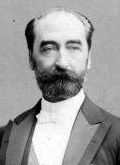 |
Marie-François-Sadi Carnot
b. 11 Aug 1837, Limoges, Haute-Vienne [1]
d. 25 Jun 1894, Lyon, Rhône |
| Title: |
Président de la République française (President of the French Republic) |
| Term: |
3 Dec 1887 - 25 Jun 1894 |
| Chronology: |
3 Dec 1887,
elected, session of the Assemblée nationale (National Assembly), salle des séances de la Chambre des députés, Palais de Versailles, Versailles [2] |
|
3 Dec 1887,
assumed the functions of office, public ceremony, Palais de Versailles, Versailles [3] |
|
25 Jun 1894, died (assassination) [4] |
| Biography: |
| Grandson of Lazare-Nicolas-Marguerite Carnot and son of Lazare-Hippolyte Carnot, member of legislatures from 1839 to 1888, minister of public instruction (24 Feb 1848 - 5 Jul 1848); attended Lycée Condorcet; educated at the École Polytechnique (1857-1860) and École des ponts et chaussées (1860-1863); after service as a government engineer at Annecy, he was named commissioner of Normandy with responsibility for organizing resistance there in the Franco-German War (1870-1871); briefly held the office of prefect of the Seine-Inférieure département and extraordinary commissioner of the Republic for Seine-Inférieure, Eure and Calvados (13 Jan 1871 - 7 Feb 1871); elected to the Assemblée nationale (National Assembly) (1871-1876) as a representative for Côte-d'Or; returned as a member of the Conseil Général of the département of Côte-d'Or from the canton of Nolay (from 1871); elected to the Chamber of Deputies (1876-1888), serving as a representative for Côte-d'Or; appointed under-secretary for public works (5 Feb 1879 - 23 Sep 1880), minister of public works (23 Sep 1880 - 14 Nov 1881, 6 Apr 1885 - 16 Apr 1885); elected vice president of the Chamber of Deputies (1883-1885); minister of finance (16 Apr 1885 - 11 Dec 1886); following the resignation of Jules Grévy, elected President of the Republic (3 Dec 1887); faced the movement led by General Boulanger, which threatened to topple the Third Republic by conspiring with monarchists and attempts to replace the constitution with more authoritarian law; government of Pierre Tirard succeeded (1889) in preventive measures and decided to prosecute Boulanger, who fled to Belgium; in May 1891 the workers' demonstration with demands of 8-hour working day resulted in casualties; the Panama scandal (1892) occurred when the press discovered that the Panama Canal Company bribed the French politicians in effort to save the collapsing project; after delivering a speech at a Lyon exposition, at about 21:10 24 Jun 1894, was stabbed by an Italian anarchist, who approached the presidential cortege; died at 00:35 25 Jun 1894. |
| Biographical sources: Dictionnaire des parlementaires français 1789-1889, 1:587-590; Picquet (1899) : "Histoire d'un français (Sadi-Carnot)", by Maurice Picquet (Paris: Picard, [1899]) (web site). |
| Elections: |
| Candidate |
1st vote (3 Dec 1887) |
2nd vote (3 Dec 1887) |
| votes cast |
852 |
842 |
| blank/invalid |
3 |
15 |
| valid votes |
849 |
827 |
| absolute majority |
425 |
414 |
| Marie-François-Sadi Carnot |
303 |
616 |
| Jules-François-Camille Ferry |
212 |
11 |
| Félix-Gustave Saussier |
148 |
188 |
| Louis-Charles de Saulces de Freycinet |
76 |
5 |
| Félix-Antoine Appert |
72 |
5 |
| Eugène-Henri Brisson |
26 |
- |
| Charles-Thomas Floquet |
5 |
1 |
| Alexandre-Anatole de La Forge |
2 |
- |
| Félix-Pyat Aimé, dit Félix Pyat |
2 |
1 |
| Louis Pasteur |
2 |
- |
| Séraphin-Jacques-Eugène Spuller |
1 |
- |
|
| Source of electoral results: Débats parlementaires, Assemblée nationale (supplement to JORF, No. 330, 4 Dec 1887), pp. 1-2. |
| |
| [1] |
Original birth record in preserved in the Archives of the Haute-Vienne département, 3 E 85 / 155, item No. 823; also published in Picquet (1899), pp. 11-12. |
| [2] |
Débats parlementaires, Assemblée nationale (supplement to JORF, No. 330, 4 Dec 1887), pp. 1-2. |
| [3] |
JORF, No. 330, 4 Dec 1887, p. 5345; Journal des débats, politiques et littéraires, Édition du matin, 4 Dec 1887, p. (2). |
| [4] |
JORF, No. 170, 25 Jun 1894, p. 2889. |

